A Data-Driven Approach to the Dimensional Synthesis of Planar Slider–Crank Function Generators
Featured Application
Abstract
1. Introduction
2. Fundamentals of Slider–Crank Linkage
2.1. Kinematic Analysis
2.2. Dimensional Synthesis Principles
3. Data-Driven Synthesis Methodology
3.1. Dataset Generation
3.1.1. Overview and Notation
- Dimension vector : A vector representing linkage dimensions, composed of the crank length r, connecting-rod length l, and offset e.
- Crank angles : A set of m input angles sampled over a full rotation , for .
- Slider positions : The corresponding slider positions computed for each , for .
3.1.2. Dimension Generation
3.1.3. Crank Angle Sampling and Slider Position Computation
3.1.4. Final Dataset Composition
3.2. Modeling and Training
3.2.1. Training Pipeline
3.2.2. Parameterized Adjustment
3.2.3. Design of LSTM-Based Architecture
- Parameterized adjustment layer derived from the geometric constraints of the slider–crank mechanism (Section 3.2.2).
- A simulation-based metric quantifying the precision-point reproducibility of the predicted linkage (Section 3.2.4).
3.2.4. Evaluation Metric
3.2.5. Random Initialization
3.2.6. Implementation Configuration
4. Results
4.1. Absolute Precision Point Case
4.2. Relative Precision Point Case
5. Conclusions
Author Contributions
Funding
Institutional Review Board Statement
Informed Consent Statement
Data Availability Statement
Conflicts of Interest
References
- Sandor, G.N. A General Complex-Number Method for Plane Kinematic Synthesis with Applications; Columbia University: New York, NY, USA, 1959. [Google Scholar]
- Erdman, A.; Sandor, G.; Kota, S. Mechanism Design: Analysis and Synthesis; Number V. 1 in Mechanism Design: Analysis and Synthesis; Prentice Hall: Hoboken, NJ, USA, 2001. [Google Scholar]
- Erdman, A.G. Three and four precision point kinematic synthesis of planar linkages. Mech. Mach. Theory 1981, 16, 227–245. [Google Scholar] [CrossRef]
- Almandeel, A.; Murray, A.P.; Myszka, D.H.; Stumph, H.E., III. A Function Generation Synthesis Methodology for All Defect-Free Slider-Crank Solutions for Four Precision Points. J. Mech. Robot. 2015, 7, 031020. [Google Scholar] [CrossRef]
- Huang, X.; He, G.; Liao, Q.; Wei, S.; Tan, X. Solving a planar four-bar linkages design problem. In Proceedings of the 2009 International Conference on Information and Automation, Zhuhai/Macau, China, 22–24 June 2009; pp. 1586–1590. [Google Scholar] [CrossRef]
- Wampler, C.W.; Morgan, A.P.; Sommese, A.J. Complete Solution of the Nine-Point Path Synthesis Problem for Four-Bar Linkages. J. Mech. Des. 1992, 114, 153–159. [Google Scholar] [CrossRef]
- Plecnik, M.M.; Michael McCarthy, J. Numerical Synthesis of Six-Bar Linkages for Mechanical Computation. J. Mech. Robot. 2014, 6, 031012. [Google Scholar] [CrossRef]
- Plecnik, M.M.; Michael McCarthy, J. Computational Design of Stephenson II Six-Bar Function Generators for 11 Accuracy Points. J. Mech. Robot. 2015, 8, 011017. [Google Scholar] [CrossRef]
- Plecnik, M.M.; McCarthy, J.M. Kinematic synthesis of Stephenson III six-bar function generators. Mech. Mach. Theory 2016, 97, 112–126. [Google Scholar] [CrossRef]
- Balli, S.S.; Chand, S. Defects in link mechanisms and solution rectification. Mech. Mach. Theory 2002, 37, 851–876. [Google Scholar] [CrossRef]
- Chase, T.R.; Mirth, J.A. Circuits and Branches of Single-Degree-of-Freedom Planar Linkages. J. Mech. Des. 1993, 115, 223–230. [Google Scholar] [CrossRef]
- Freudenstein, F. Approximate Synthesis of Four-Bar Linkages. Trans. Am. Soc. Mech. Eng. 1955, 77, 853–859. [Google Scholar] [CrossRef]
- Plecnik, M.M.; McCarthy, J.M. Five Position Synthesis of a Slider-Crank Function Generator. In Proceedings of the ASME 2011 International Design Engineering Technical Conferences & Computers and Information in Engineering Conference (IDETC/CIE), Washington, DC, USA, 28–31 August 2011; pp. 317–324. [Google Scholar] [CrossRef]
- McLarnan, C.W. Synthesis of Six-Link Plane Mechanisms by Numerical Analysis. J. Eng. Ind. 1963, 85, 5–10. [Google Scholar] [CrossRef]
- Akhras, R.; Angeles, J. Unconstrained nonlinear least-square optimization of planar linkages for rigid-body guidance. Mech. Mach. Theory 1990, 25, 97–118. [Google Scholar] [CrossRef]
- Suh, C.; Mecklenburg, A. Optimal design of mechanisms with the use of matrices and least squares. Mech. Mach. Theory 1973, 8, 479–495. [Google Scholar] [CrossRef]
- Shariati, M.; Norouzi, M. Optimal synthesis of function generator of four-bar linkages based on distribution of precision points. Meccanica 2011, 46, 1007–1021. [Google Scholar] [CrossRef]
- Porta, J.M.; Ros, L.; Creemers, T.; Thomas, F. Box Approximations of Planar Linkage Configuration Spaces. J. Mech. Des. 2006, 129, 397–405. [Google Scholar] [CrossRef]
- Javash, M.S.; Ettefagh, M.M.; Hamidi, Y.E. Optimum design method for four-bar function generator using AIS and genetic algorithms. In Proceedings of the 2013 IEEE INISTA, Albena, Bulgaria, 19–21 June 2013; pp. 1–6. [Google Scholar] [CrossRef]
- Rao, A. Synthesis of 4-bar function-generators using geometric programming. Mech. Mach. Theory 1979, 14, 141–149. [Google Scholar] [CrossRef]
- Cabrera, J.; Simon, A.; Prado, M. Optimal synthesis of mechanisms with genetic algorithms. Mech. Mach. Theory 2002, 37, 1165–1177. [Google Scholar] [CrossRef]
- Ortiz, A.; Cabrera, J.; Nadal, F.; Bonilla, A. Dimensional synthesis of mechanisms using Differential Evolution with auto-adaptive control parameters. Mech. Mach. Theory 2013, 64, 210–229. [Google Scholar] [CrossRef]
- Vasiliu, A.; Yannou, B. Dimensional synthesis of planar mechanisms using neural networks: Application to path generator linkages. Mech. Mach. Theory 2001, 36, 299–310. [Google Scholar] [CrossRef]
- Hoskins, J.; Kramer, G. Synthesis of mechanical linkages using artificial neural networks and optimization. In Proceedings of the IEEE International Conference on Neural Networks, San Francisco, CA, USA, 28 March–1 April 1993; p. 822-J. [Google Scholar] [CrossRef]
- Khan, N.; Ullah, I.; Al-Grafi, M. Dimensional synthesis of mechanical linkages using artificial neural networks and Fourier descriptors. Mech. Sci. 2015, 6, 29–34. [Google Scholar] [CrossRef]
- Kim, W.R.; Jung, J.; Ha, J.U.; Lee, D.; Shim, J.K. Data-Driven Dimensional Synthesis of Diverse Planar Four-bar Function Generation Mechanisms via Direct Parameterization. arXiv 2025, arXiv:2507.08269. [Google Scholar]
- Yim, N.H.; Lee, J.; Kim, J.; Kim, Y.Y. Big data approach for the simultaneous determination of the topology and end-effector location of a planar linkage mechanism. Mech. Mach. Theory 2021, 163, 104375. [Google Scholar] [CrossRef]
- Yim, N.H.; Ryu, J.; Kim, Y.Y. Big data approach for synthesizing a spatial linkage mechanism. In Proceedings of the 2023 IEEE International Conference on Robotics and Automation (ICRA), London, UK, 29 May–2 June 2023; pp. 7433–7439. [Google Scholar] [CrossRef]
- Kwak, S.W.; Shim, J.K.; Mo, Y.K. Kinematic Conceptual Design of In-Line Four-Cylinder Variable Compression Ratio Engine Mechanisms Considering Vertical Second Harmonic Acceleration. Appl. Sci. 2020, 10, 3765. [Google Scholar] [CrossRef]
- Freudenstein, F. An Analytical Approach to the Design of Four-Link Mechanisms. Trans. Am. Soc. Mech. Eng. 1954, 76, 483–489. [Google Scholar] [CrossRef]
- Yu, J.; Li, Y.; Yang, H.; Zhang, Y. Physics-Informed Machine Learning for Mechanical Performance Prediction of ECC-Strengthened Reinforced Concrete Beams: An Empirical-Guided Framework. Math. Comput. Appl. 2025, 30, 94. [Google Scholar] [CrossRef]
- Regenwetter, L.; Giannone, G.; Srivastava, A.; Gutfreund, D.; Ahmed, F. Constraining Generative Models for Engineering Design with Negative Data. arXiv 2023, arXiv:2306.15166. [Google Scholar]
- Nurizada, A.; Dhaipule, R.; Lyu, Z.; Purwar, A. A Dataset of 3M Single-DOF Planar 4-, 6-, and 8-Bar Linkage Mechanisms With Open and Closed Coupler Curves for Machine Learning-Driven Path Synthesis. J. Mech. Des. 2024, 147, 041702. [Google Scholar] [CrossRef]
- Jiang, N.; Zhang, M.; van Hoeve, W.J.; Xue, Y. Constraint Reasoning Embedded Structured Prediction. J. Mach. Learn. Res. 2022, 23, 1–40. [Google Scholar]
- Schweidtmann, A.M.; Weber, J.M.; Wende, C.; Mitsos, A. Obey validity limits of data-driven models through topological data analysis and one-class classification. Optim. Eng. 2022, 23, 855–876. [Google Scholar] [CrossRef]
- Hochreiter, S.; Schmidhuber, J. Long Short-Term Memory. Neural Comput. 1997, 9, 1735–1780. [Google Scholar] [CrossRef]
- Shiri, F.M.; Perumal, T.; Mustapha, N.; Mohamed, R. A comprehensive overview and comparative analysis on deep learning models: CNN, RNN, LSTM, GRU. arXiv 2023, arXiv:2305.17473. [Google Scholar] [CrossRef]
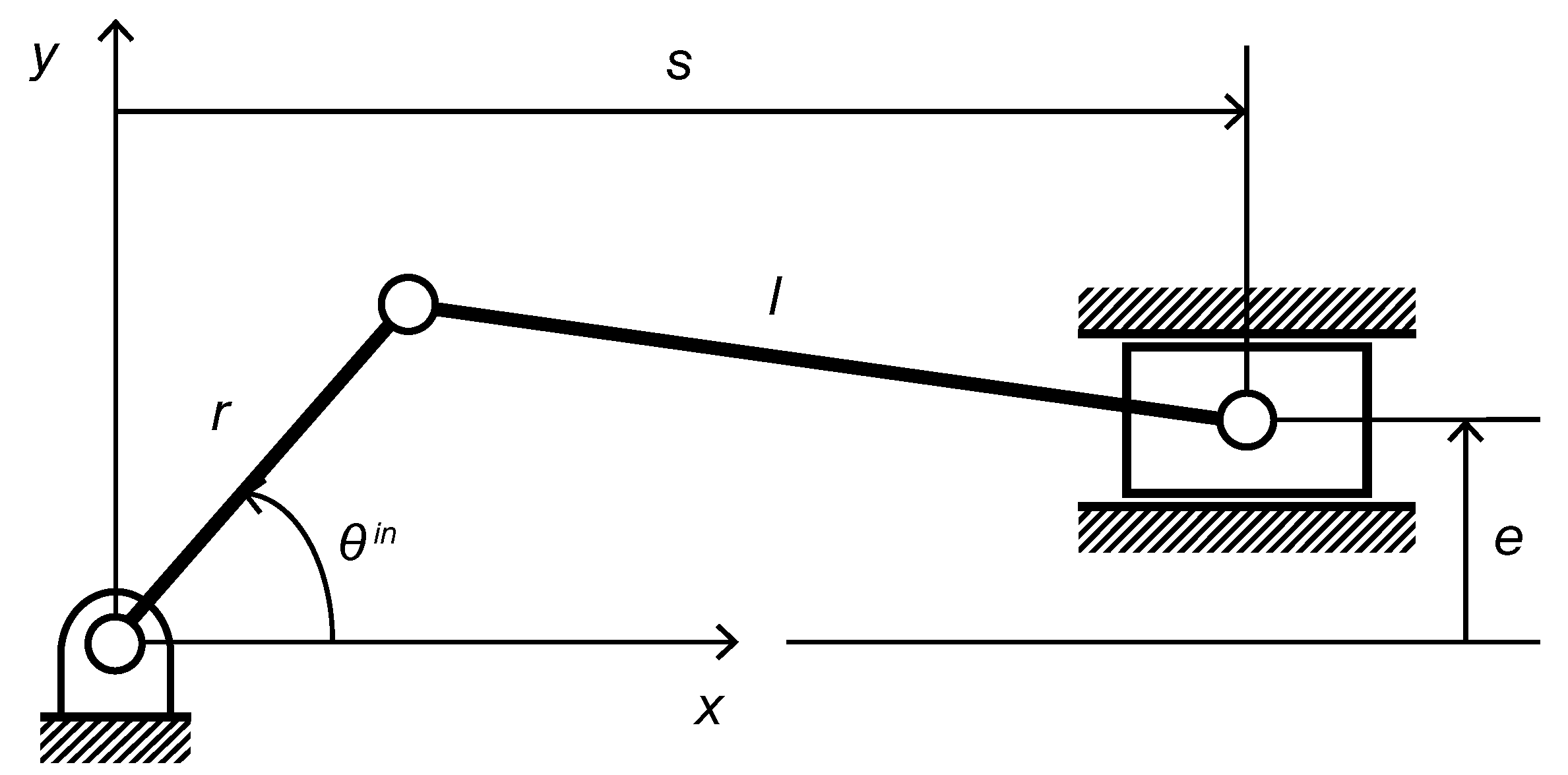

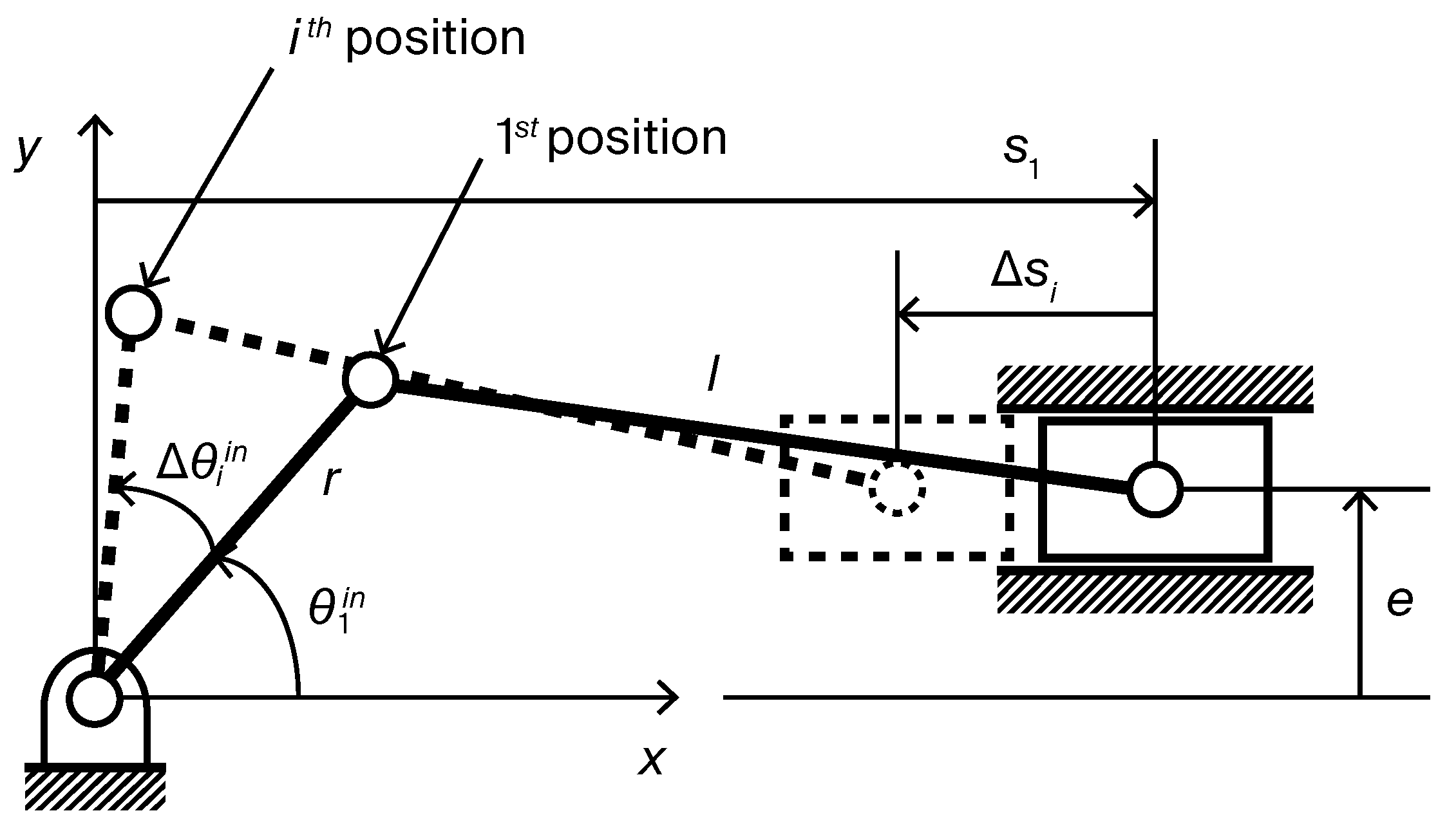
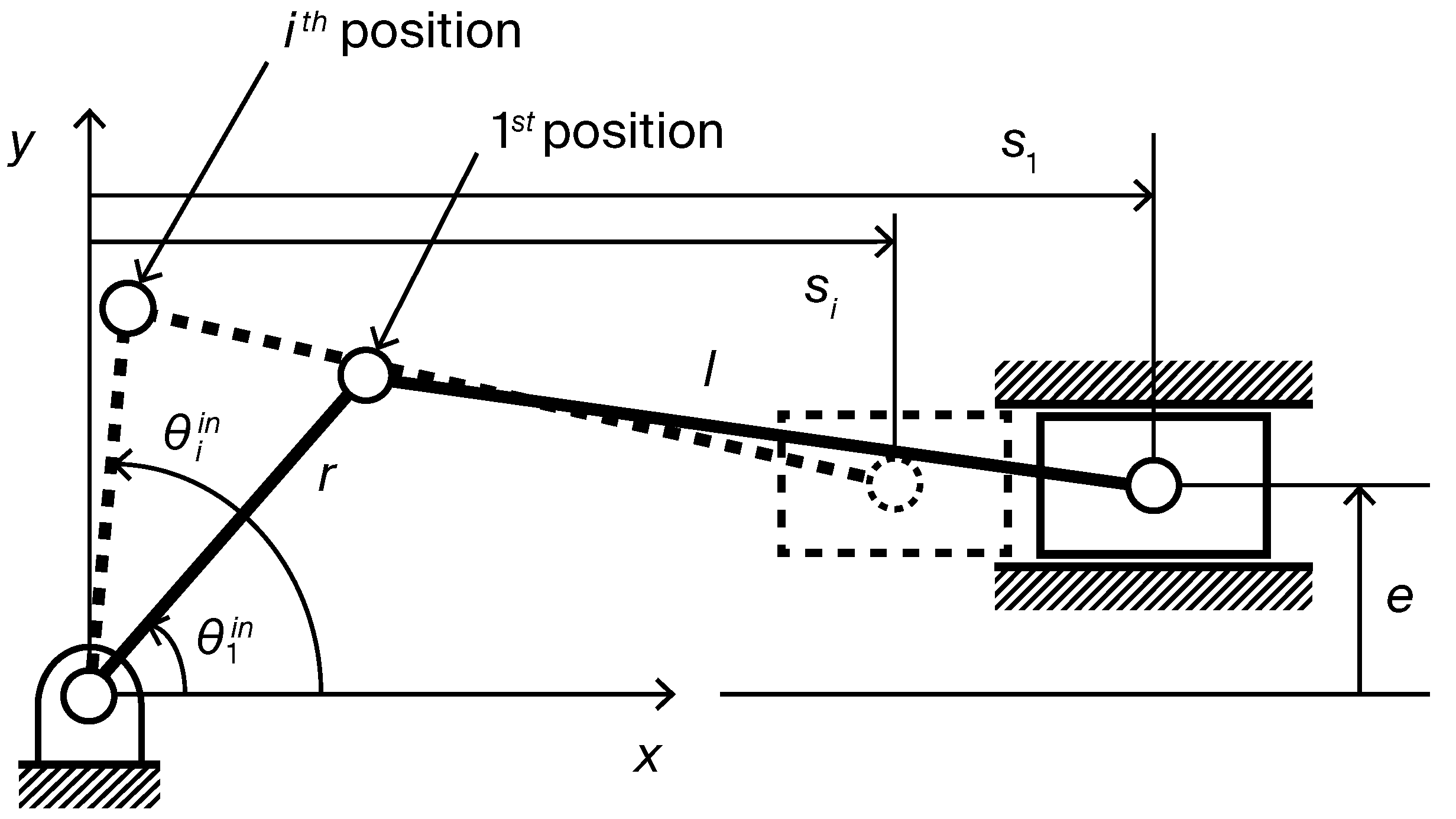
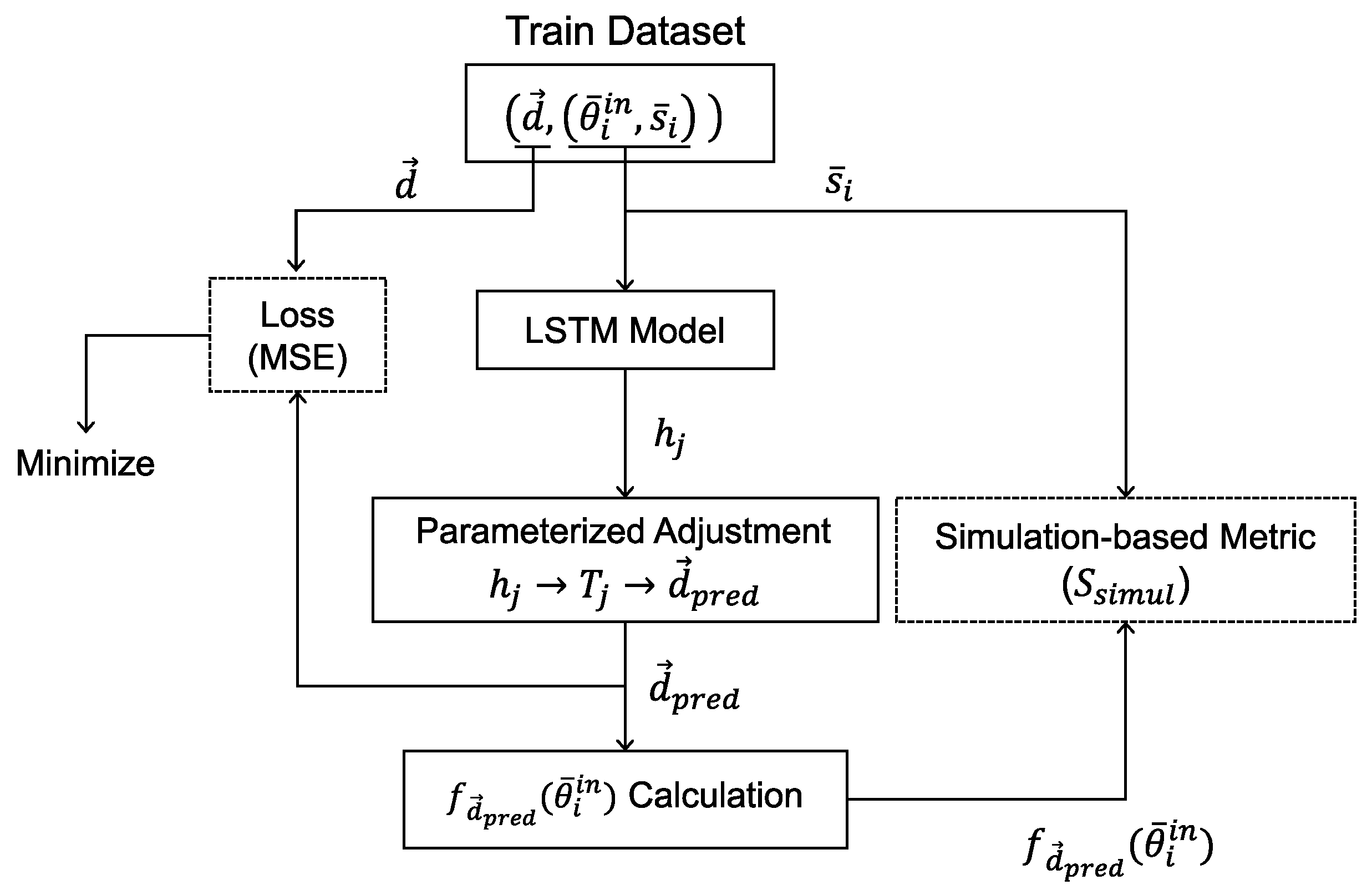
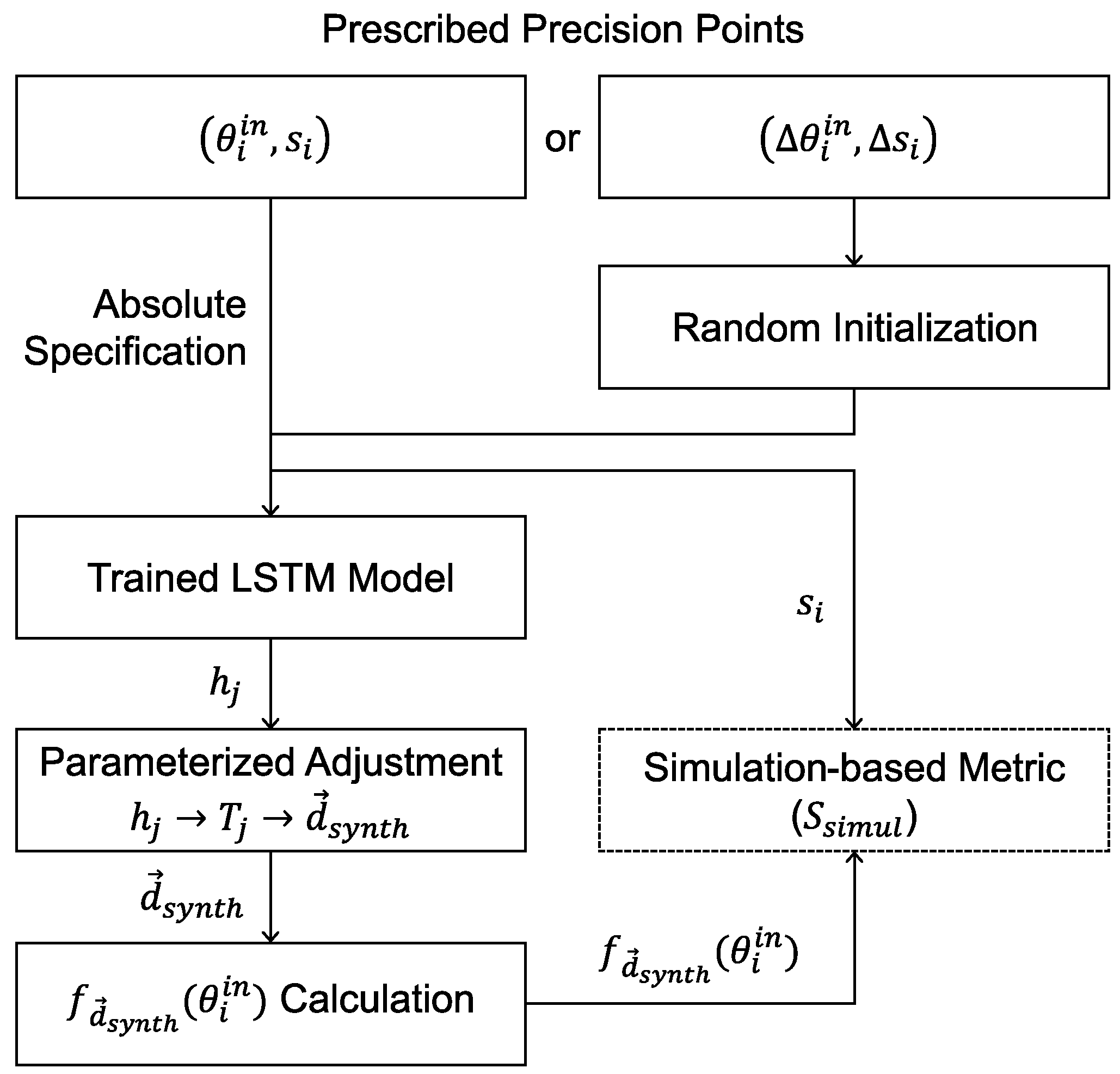
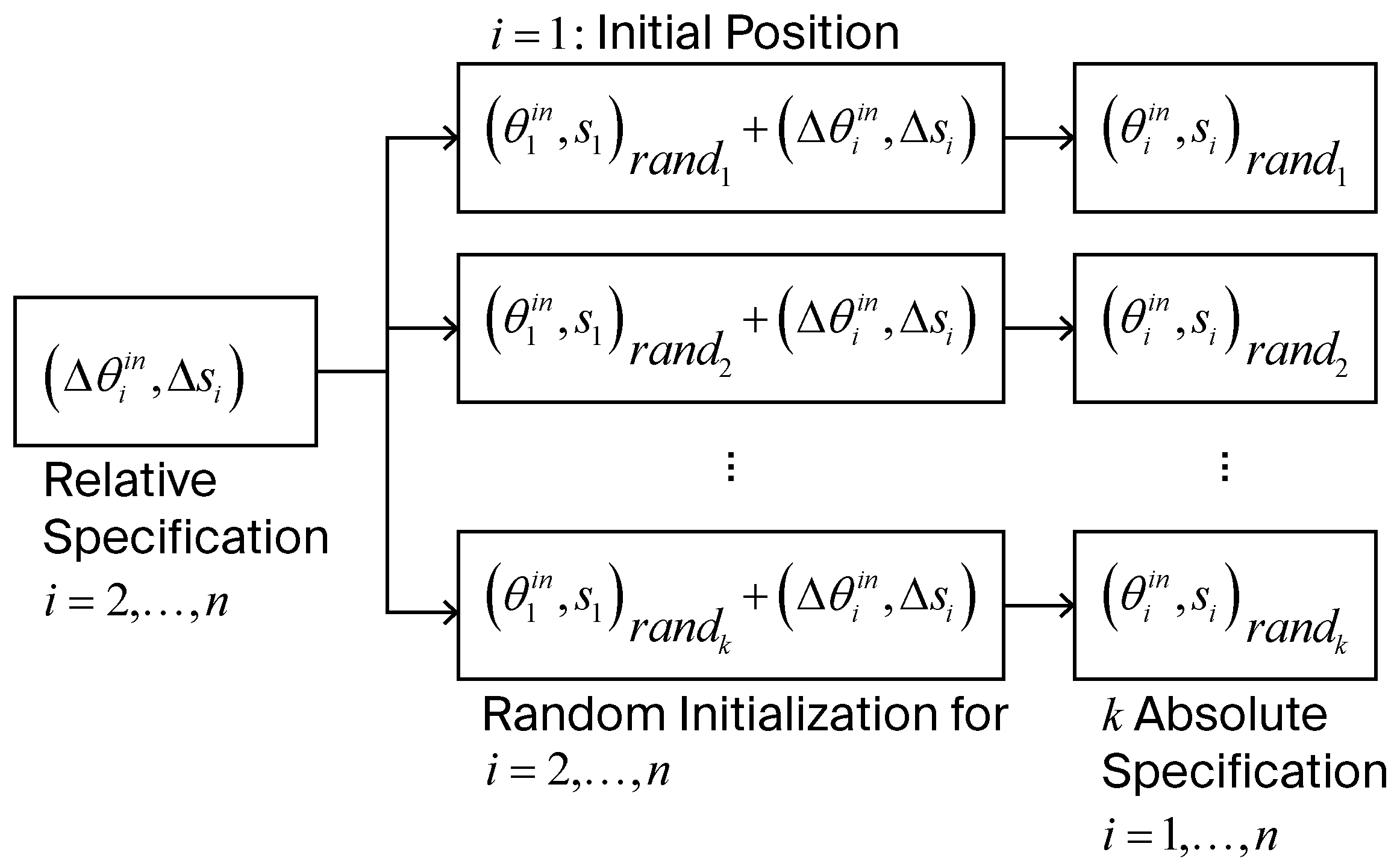

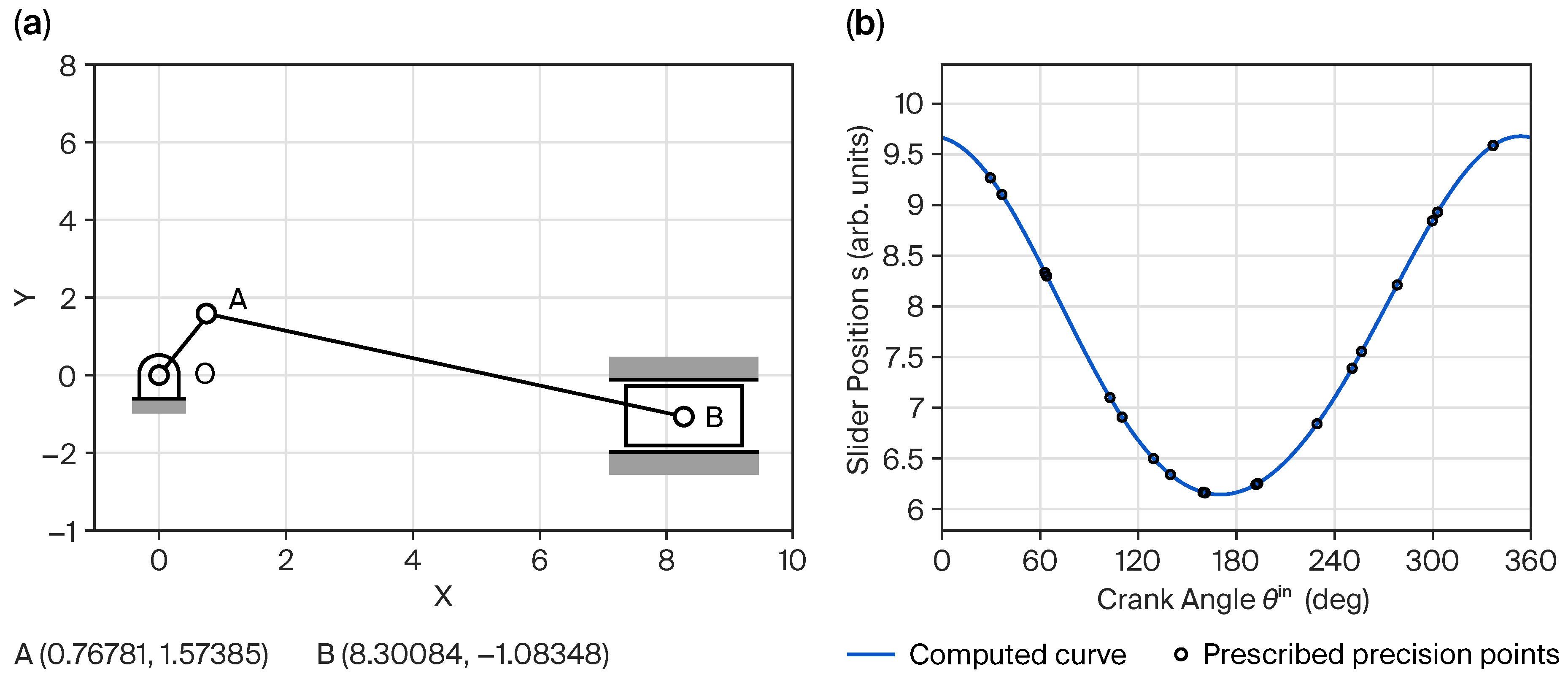
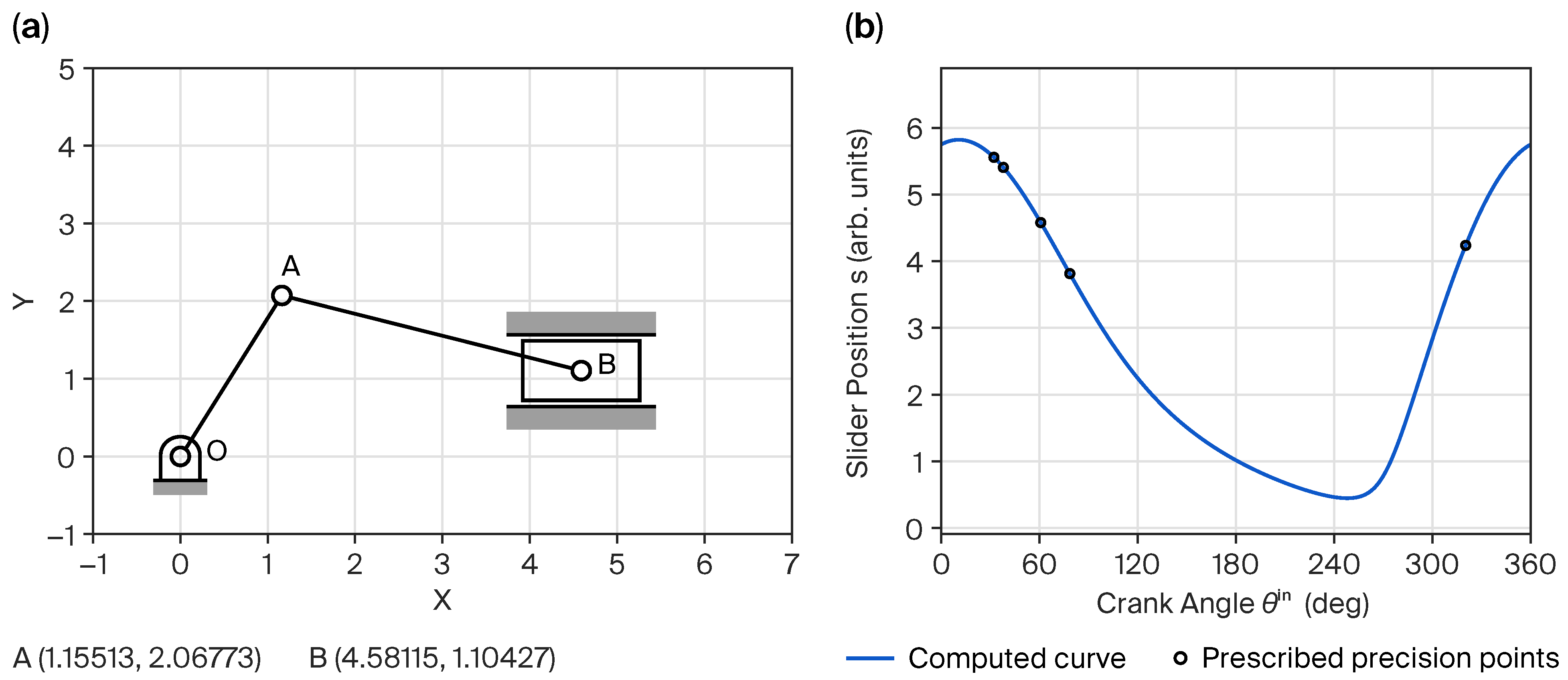

| Precision Points i | 1 | 2 | 3 |
|---|---|---|---|
| (deg) | 24.13994 | 67.79331 | 346.74814 |
| 4.18589 | 3.50447 | 3.82519 | |
| 4.18588 | 3.50459 | 3.82525 | |
| Error |
| Precision Points i | 1 | 2 | 3 | 4 | 5 | 6 | 7 | 8 | 9 | 10 |
|---|---|---|---|---|---|---|---|---|---|---|
| (deg) | 29.60856 | 36.66751 | 62.91374 | 63.99442 | 102.69051 | 110.05724 | 129.35355 | 139.58070 | 159.55408 | 160.07394 |
| 9.26900 | 9.10346 | 8.33538 | 8.30064 | 7.09929 | 6.90678 | 6.49638 | 6.34025 | 6.16506 | 6.16280 | |
| 9.26914 | 9.10361 | 8.33558 | 8.30084 | 7.09952 | 6.90700 | 6.49658 | 6.34044 | 6.16521 | 6.16295 | |
| Error | ||||||||||
| Precision Points | 11 | 12 | 13 | 14 | 15 | 16 | 17 | 18 | 19 | 20 |
| (deg) | 160.84009 | 191.93729 | 192.97054 | 229.21844 | 250.69785 | 256.46171 | 278.18599 | 299.71103 | 302.88215 | 336.86957 |
| 6.15969 | 6.24200 | 6.25155 | 6.84049 | 7.38885 | 7.55405 | 8.21088 | 8.84394 | 8.92934 | 9.58854 | |
| 6.15983 | 6.24208 | 6.25162 | 6.84050 | 7.38884 | 7.55403 | 8.21086 | 8.84392 | 8.92933 | 9.58857 | |
| Error |
| Precision Points i | 2 | 3 | 4 | 5 | |
|---|---|---|---|---|---|
| (deg) | 71.81015 | 77.58688 | 100.42560 | 118.16217 | |
| 1.32056 | 1.16901 | 0.34203 | −0.42381 | ||
| Absolute Points | 1 | 2 | 3 | 4 | 5 |
| (deg) | 320.38478 | 32.19493 | 37.97166 | 60.81038 | 78.54695 |
| 4.23826 | 5.55882 | 5.40727 | 4.58029 | 3.81445 | |
| 4.23917 | 5.55975 | 5.40850 | 4.58115 | 3.81465 | |
| Error |
| Precision Points i | 2 | 3 | 4 | 5 | 6 | 7 | 8 | 9 | 10 | |
|---|---|---|---|---|---|---|---|---|---|---|
| (deg) | 0.55675 | 27.41502 | 41.80560 | 67.90254 | 79.02496 | 82.92163 | 116.36668 | 130.96936 | 159.47870 | |
| 0.00212 | 0.18893 | 0.35093 | 0.72389 | 0.89999 | 0.96223 | 1.45451 | 1.61457 | 1.76688 | ||
| Absolute Points | 1 | 2 | 3 | 4 | 5 | 6 | 7 | 8 | 9 | 10 |
| (deg) | 201.60580 | 202.16255 | 229.02082 | 243.41140 | 269.50834 | 280.63076 | 284.52743 | 317.97248 | 332.57516 | 1.08450 |
| 6.64163 | 6.64375 | 6.83056 | 6.99256 | 7.36552 | 7.54162 | 7.60386 | 8.09614 | 8.25620 | 8.40851 | |
| 6.64006 | 6.64218 | 6.82933 | 6.99167 | 7.36547 | 7.54198 | 7.60437 | 8.09788 | 8.25835 | 8.41107 | |
| Error | ||||||||||
| Precision Points | 11 | 12 | 13 | 14 | 15 | 16 | 17 | 18 | 19 | 20 |
| (deg) | 160.97011 | 167.65310 | 192.85896 | 206.31934 | 232.79431 | 234.95798 | 263.98210 | 294.58545 | 317.92820 | 327.28235 |
| 1.76824 | 1.76598 | 1.63895 | 1.50334 | 1.14284 | 1.10994 | 0.66166 | 0.25736 | 0.05491 | 0.00653 | |
| Absolute Points | 11 | 12 | 13 | 14 | 15 | 16 | 17 | 18 | 19 | 20 |
| (deg) | 2.57591 | 9.25890 | 34.46476 | 47.92514 | 74.40011 | 76.56378 | 105.58790 | 136.19125 | 159.53400 | 168.88815 |
| 8.40987 | 8.40761 | 8.28058 | 8.14497 | 7.78447 | 7.75157 | 7.30329 | 6.89899 | 6.69654 | 6.64816 | |
| 8.41244 | 8.41018 | 8.28285 | 8.14691 | 7.78554 | 7.75257 | 7.30325 | 6.89804 | 6.69515 | 6.64665 | |
| Error |
Disclaimer/Publisher’s Note: The statements, opinions and data contained in all publications are solely those of the individual author(s) and contributor(s) and not of MDPI and/or the editor(s). MDPI and/or the editor(s) disclaim responsibility for any injury to people or property resulting from any ideas, methods, instructions or products referred to in the content. |
© 2025 by the authors. Licensee MDPI, Basel, Switzerland. This article is an open access article distributed under the terms and conditions of the Creative Commons Attribution (CC BY) license (https://creativecommons.org/licenses/by/4.0/).
Share and Cite
Kim, W.R.; Shim, J.K. A Data-Driven Approach to the Dimensional Synthesis of Planar Slider–Crank Function Generators. Appl. Sci. 2025, 15, 12554. https://doi.org/10.3390/app152312554
Kim WR, Shim JK. A Data-Driven Approach to the Dimensional Synthesis of Planar Slider–Crank Function Generators. Applied Sciences. 2025; 15(23):12554. https://doi.org/10.3390/app152312554
Chicago/Turabian StyleKim, Woon Ryong, and Jae Kyung Shim. 2025. "A Data-Driven Approach to the Dimensional Synthesis of Planar Slider–Crank Function Generators" Applied Sciences 15, no. 23: 12554. https://doi.org/10.3390/app152312554
APA StyleKim, W. R., & Shim, J. K. (2025). A Data-Driven Approach to the Dimensional Synthesis of Planar Slider–Crank Function Generators. Applied Sciences, 15(23), 12554. https://doi.org/10.3390/app152312554






